- 29 Mar 2023
- 10 Minutes To Read
- Print
- DarkLight
- PDF
Interest Calculation Methods in Loans
- Updated On 29 Mar 2023
- 10 Minutes To Read
- Print
- DarkLight
- PDF
Interest on loans is accrued on a daily basis, which allows you to charge your clients only for the days they used the loan amount.
For example, if a client pays back the loan amount before the due date, Mambu will display the exact interest amount that the client owes at that moment. Also, when a repayment is late, interest will keep accumulating each day.
The only calculation method in which interest is not accrued in Mambu is Fixed Flat. When using this method, the interest always reflects the amount that would be due on the due date, regardless of the actual payment date.
There are three different interest calculation methods you can choose from for your loan product:
- Fixed Flat
- Declining Balance
- Declining Balance (Equal Installments)
When creating a new loan product, you must choose one of these methods for that product and all the accounts created under it.
Below you can find an example of how the repayment schedules would look for each of the interest calculation methods. The loan details for every example below are:
- Loan Amount: USD1000
- Interest Rate: 10%
- Number of installments: 4
- Monthly repayments
- Interest Rate Frequency: Monthly
- Disbursement Date: 2011/1/23
- Days in year: 365 days
Fixed Flat
The Fixed Flat calculation method is the only method for which interest is not accrued over time. All interest and principal become due immediately upon disbursement regardless of the first repayment date.
The interest due depends only on the interest rate, principal amount and time between repayments.

Declining Balance
The Declining Balance method reflects the actual cost of the loan more accurately than the Fixed Flat method, as the interest is calculated on the outstanding balance.
The client only pays interest on the actual amount they still owe and not on the total amount (as is the case with the Fixed Flat method).
In this case, as the client starts making repayments, the interest due keeps decreasing over the duration of the loan.

Declining Balance (Equal Installments)
The Declining Balance (Equal Installments) method is similar to the Declining Balance method in that the interest is calculated on the outstanding principal amount. However the difference between these two calculation methods is that for the Declining Balance (Equal Installments) method, the client pays equal installments for the duration of the loan. This is achieved by increasing the amount of principal being repayed as the interest decreases, adding up to the same fixed amount for each installment.

Non-equal installments due to rounding and first repayment date
In some situations, one of the installments may be slightly different from the others.
This can occur when the time from disbursement until the first repayment date is longer than the time between each installment. In this case, there will be more interest accrued and less principal in the first installment, and the remaining principal is added to the last or to the first installment – as defined in the loan product settings.
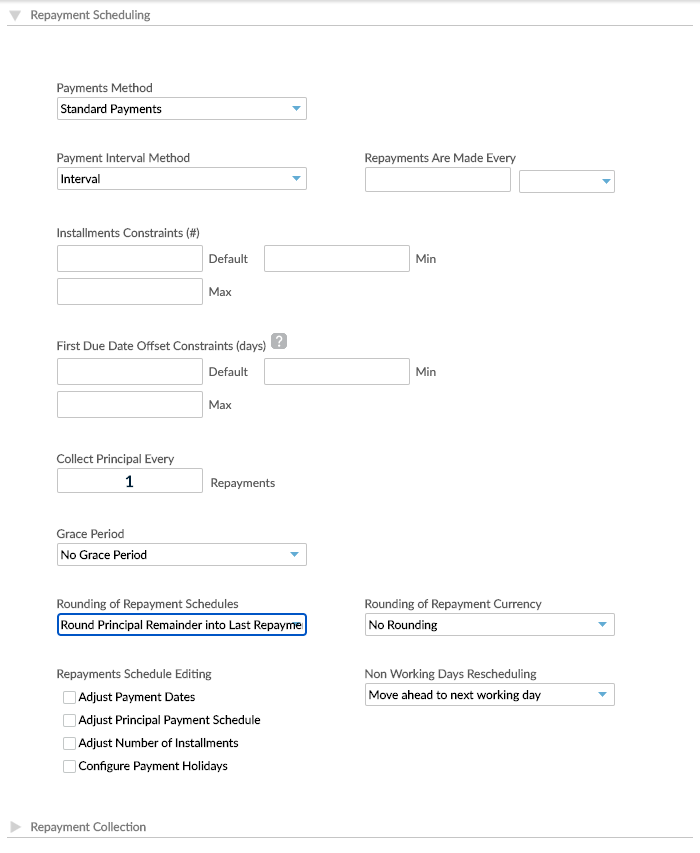
Accrue Late Interest
Normally, businesses have the right to charge interest on late payments. However, you may want to disable this option if, for example, you want to create a flexible product which rewards clients for paying on time rather than penalises them for paying late.
Accrue Late Interest is enabled by default for all kinds of Dynamic Term Loans.
However, you can disable it in order not to accrue and apply late interest but only if the Declining Balance (Equal Installments) interest calculation method is chosen. For all the other interest calculation methods, interest will be accrued by default and you don't have the option to change that.
The possibility to disable Accrue Late Interest is available for any Pre-Payment Allocation method as well as for all payment methods (Standard and Balloon).
The feature is available via API 2.0 and Mambu UI.
To disable the Accrue Late Interest checkbox in the Mambu UI, follow these steps (click to expand):
Under Product Type , select Dynamic Term Loan.
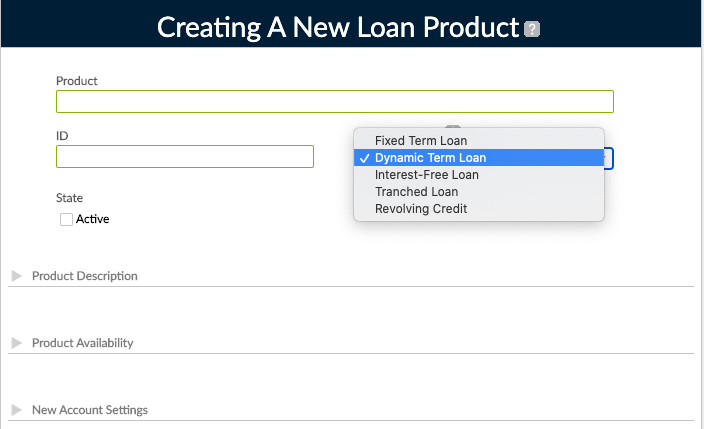
In the Interest Rate section, set the Interest Calculation Method to Declining Balance (Equal Installments).
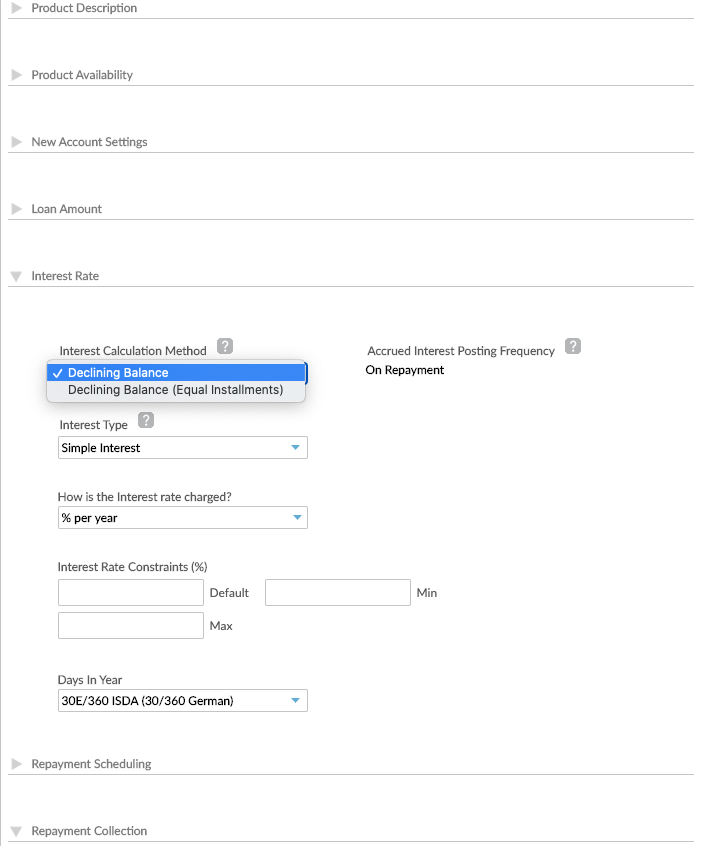
In the Repayment Scheduling section, ensure that the Payments Method is set to Standard Payments.
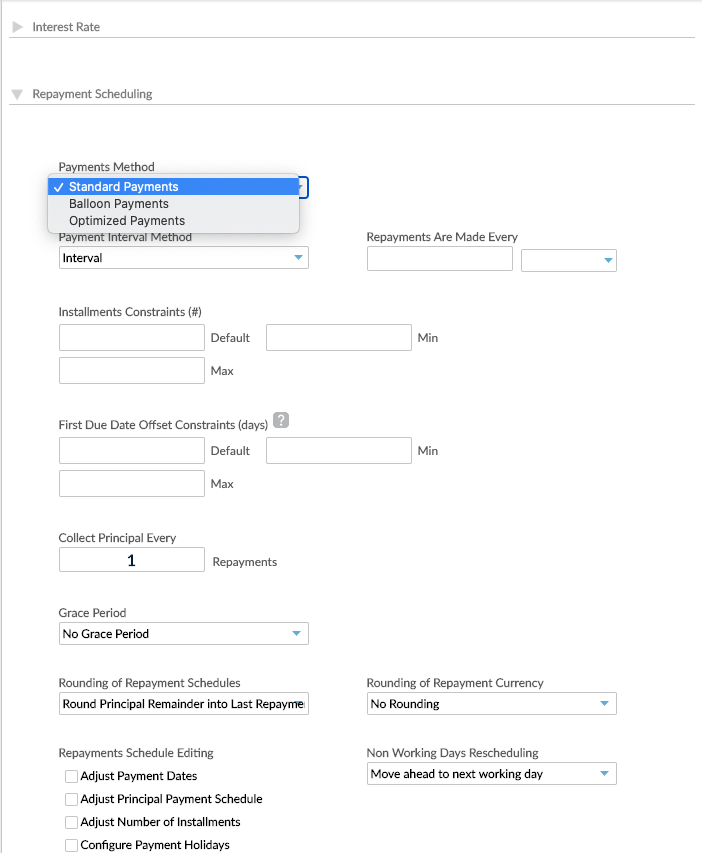
In the Repayment Collection section, set the Pre-Payment Allocation method to On Upcoming Pending Installment Only. This uncovers the options for Pre-Payment Recalculation methods in the same section.
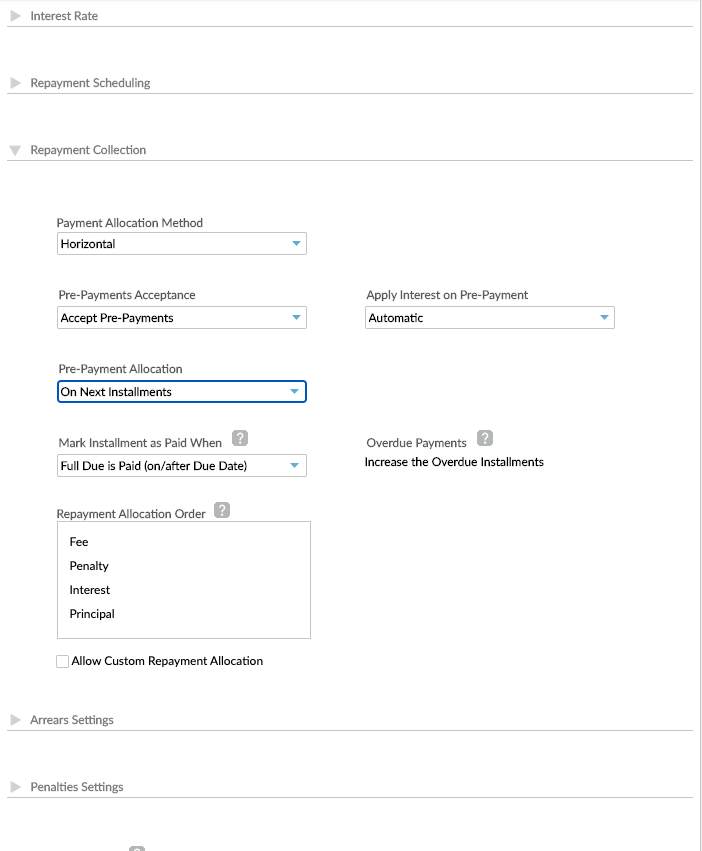
Set the Pre-Payment Recalculation method to Reduce Number of Installments. This uncovers the Accrue Late Interest checkbox in the Interest Rate section.
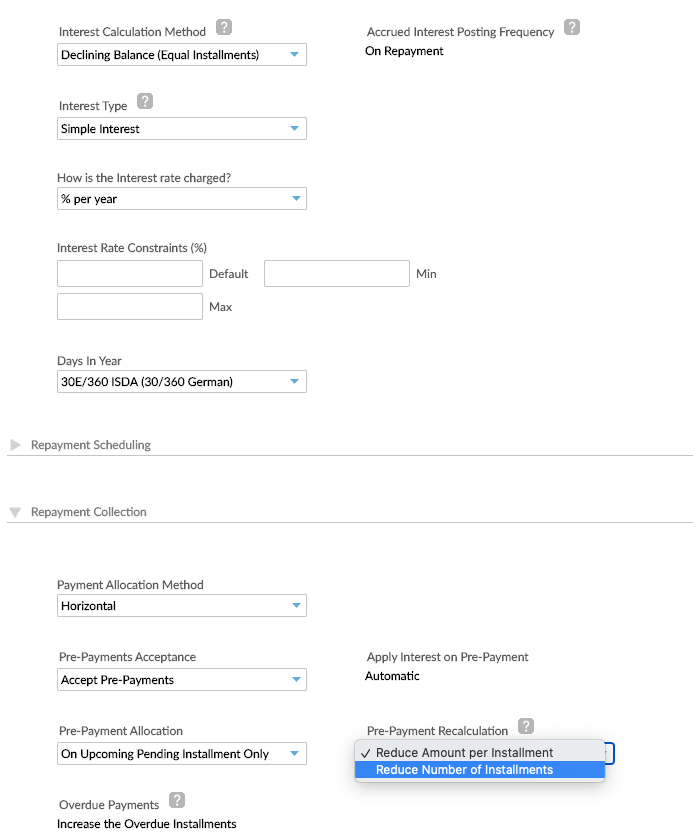
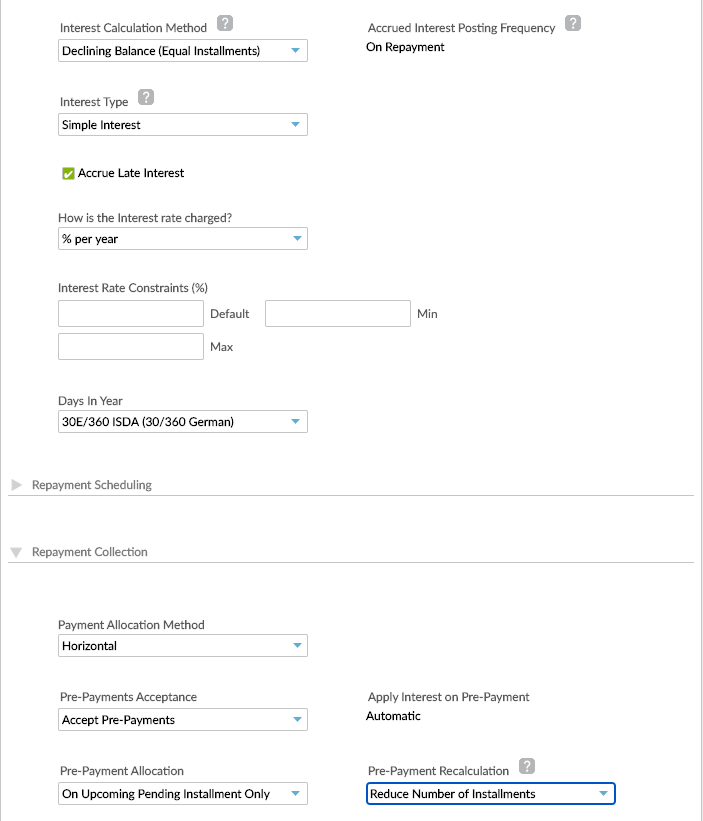
Interest Rate Source
You can set up two types of interest rate sources, via the Interest Rate Source setting of a loan product:
- Fixed: a fixed interest rate source, which is used for the the entire lifetime of the loan.
- Indexed: the interest rate source is tied to a specific benchmark (determined by an external entity—such as the government) with rate changes based on the movement of the benchmark. In this case, loans will need to be updated to reflect the new interest rate whenever it changes.
Click to see where to set the Index Rate Source option for loan products.
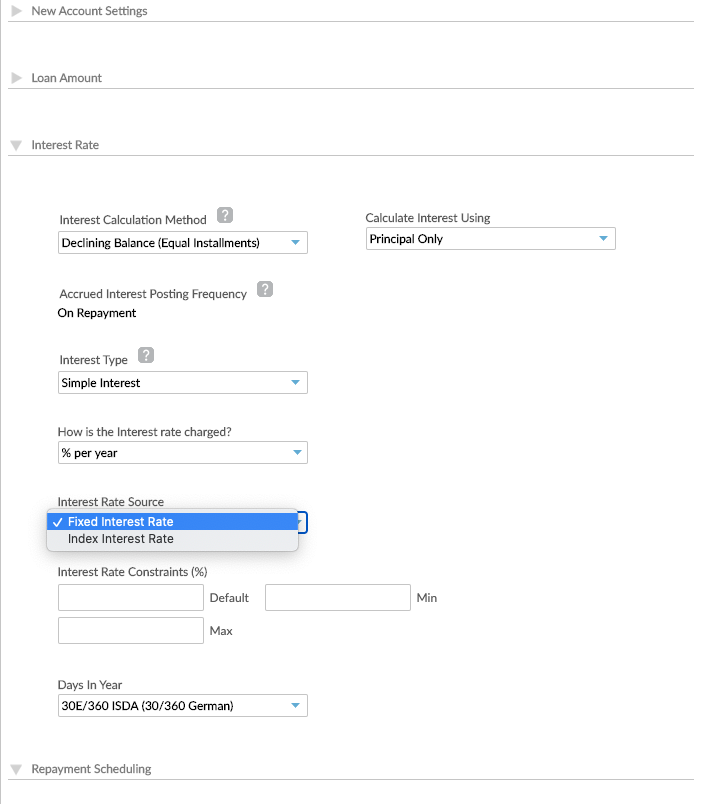
The frequency at which the interest rate should be reviewed is determined when creating a product and can be set on a daily, weekly or monthly basis. If there is a new interest rate when the review is made, then all loans using that source as an Index Interest Rate will be updated.
Interest rate changes will take effect immediately on the account as per the scheduled review frequency date or period as follows:
• For a standard loan with both principal and interest: the upcoming installment due amount will not be changed (this will be done by adjusting the principal component of that installment).
• For an interest only loan: the upcoming installment due amount will be changed right away as there will not be any principal component available to adjust the installment amount.
Example
Consider a loan with the following terms:
- Loan Amount: USD1000
- Interest: 5% (index) + 2% (spread)
- Monthly Installments
- Disbursal date: December 13, 2022
- Interest Frequency Review: Monthly
Now suppose that on January 1, 2023, the Central Bank keeps the Index rate at 5% and on February 1 increases it to 6%. The change will affect the loan's repayment schedule, according to the frequency review (in this case, the interest rate will change starting from March 13, 2023, one month from the review):
- First installment on January 13, 2023:
Interest = 5% Index + 2% Spread = 7%and the total interest due will not be changed. - Second installment on February 13, 2023:
Interest = 5% Index + 2% Spread = 7%and total interest due will not be changed. - Third Installment on March 13, 2023:
Interest = 6% Index + 2% Spread = 8%and total interest due will be changed (in case of equal installments, a new PMT will be generated, based on the new interest rate). - All the following installments will use
Interest = 6% Index + 2% Spread = 8%.
Index Rate Constraints
You can apply a floor (min) or ceiling (max) to index interest rates as well. This means the combined index and spread cannot be less than or more than a predefined value. These limitations can be defined as part of the loan product configuration, and they will apply to all accounts based on this loan product. In addition, you can set a default for the interest rate.
Click to see where to set the Interest Rate Default, Floor and Ceiling for loan products.
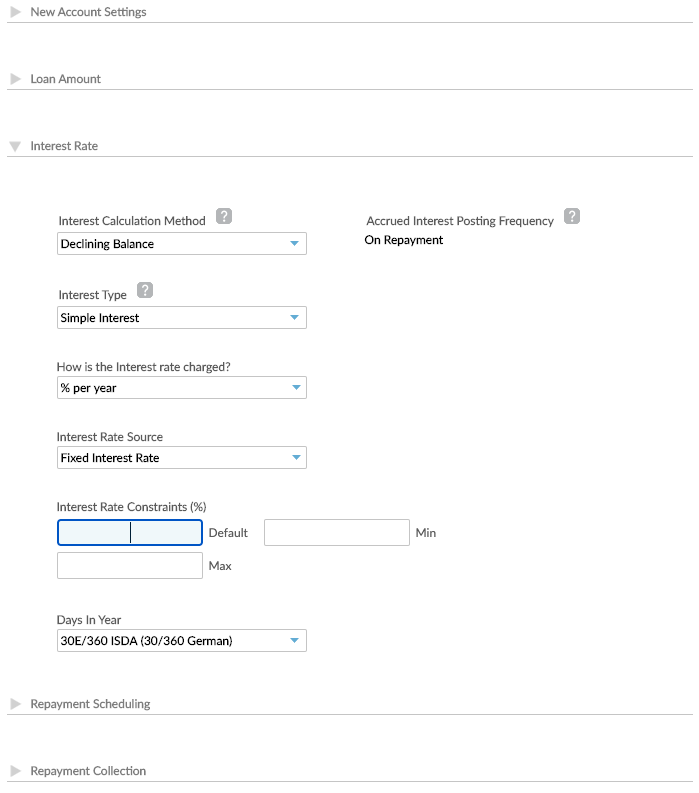
Example
Assume the floor rate is 10% and the ceiling rate is 20%.
| Index Interest Rate | Spread | Calculated Rate | Actual Rate |
|---|---|---|---|
| 10 | 5 | 15 | 15 |
| 10 | 17 | 37 | 20 |
| 5 | 3 | 8 | 10 |
Days in Year
The day count convention, also referred to as day count fraction or day count, determines how interest accrues over time in a variety of transactions, including bonds, swaps, bills, and loans.
Because months and years have different numbers of days, calculating interest for different periods can be complicated and susceptible to error. To address this, day count conventions were developed to standardise this methodology, to avoid disputes and provide uniformity and transparency.
Based on the market and financial product, you can choose from the following day count conventions that Mambu has to offer.
Actual/365 Fixed
The Actual/365 Fixed is a day count convention that counts the actual number of days in each month, but deems each year to be 365 days. It applies in leap years as well as in normal years.
Example
Let’s consider a loan with the following terms.
Loan amount : USD 1000
Interest rate: 10% per year
Number of installments: 5
Formula:
Annual Interest Rate * Outstanding principal balance/365 * Number of days in the target month
Interest expected for one month with 30 days: 10%* 1000/365 * 30 = USD 8.22
Interest expected for one month with 31 days: 10%* 1000/365 * 31 = USD 8.49
Actual/360
Actual/360 is a day count convention that counts the actual number of days in each month, but deems each year to be 360 days.
Example
For the same loan terms as in the example above, the interest expected is calculated as follows.
Formula:
Annual Interest Rate * Outstanding principal balance/360 * Number of days in the target month
Interest expected for one month with 28 days: 10%* 1000/360 * 28 = USD 7.78
Interest expected for one month with 31 days: 10%* 1000/360 * 31 = USD 8.61
30E/360 ISDA
The 30E/360 ISDA day count convention deems all months to be 30 days in length and each year to be 360 days. With this method, the interest accrues at a daily interest rate equal to 1/360th of the interest rate, but for each full month is deemed to accrue for 30 days, regardless whether the month has 28, 29, 30, or 31 days. Therefore, for a month with 31 days, the number of accrued interest days will be the same on the 31st of that month as on the 30th while the last day of February is considered to be the 30th day of the month. In all cases, with this day count convention, the total number of days in a year will always be 360.
Example
For the same loan terms as in the examples above, the interest expected is
calculated as follows.
Formula:
Annual Interest Rate * Outstanding principal balance/360*30
Interest expected for one month with 28 days: 10%* 1000/360 * 30 = USD 8.33
Interest expected for one month with 31 days: 10%* 1000/360 * 30 = USD 8.33
BUS/252
This feature is not available by default.
If you would like to request access to this feature, please get in touch with your Mambu Customer Success Manager to discuss your requirements. For more information, see Mambu Release Cycle - Feature Release Status.
BUS/252 is a day count method that supports the characteristics of the Brazilian Day Count Accrual convention. This method is based on the Brazilian business calendar, where the average number of business days in a year is 252. The interest calculated using this day count convention takes into consideration only the working days of the year.
The method excludes, by default, Saturdays and Sundays from the interest accrual computation. Adding them in Mambu administration is not required. However, general holidays need to be added in Mambu Administration as they are considered when accruing interest under the BUS/252 day count convention .
This day count convention is available in Mambu only for the loan products with Compound Interest type. For more information, see Interest Types.
Example
Consider a loan with the following terms.
Loan amount: BRL 10000
Interest Rate: 10% per year
Interest Type: Compound interest (Compounded Frequency: Daily )
Disbursement date: 01.05.2022
Compound interest formula:
Outstanding Principal Balance * ( (1+Annual Interest Rate %) ^ (NoOfDays/DaysInYear)-1 )
where DaysInYear = 252 (according to product setup with BUS/252 day count convention)
Interest accrued for one working day: 10000*((1+0.10)^(1/252)-1) = BRL 3.78
Interest expected for May 2022, which has 31 calendar days but only 22 working days: 10000*((1+0.10)^(22/252)-1) = BRL 83.55
Days in arrears are calculated based only on Non-Working Days in Arrears Tolerance Period and Penalty Calculation Method option set at the product level (either Exclude Non-Working Days or Include Non-Working Days). The BUS 252 day count convention does not have any impact on the days in arrears computation.
Late days are always calculated as days elapsed either from the date the account first went into arrears or from the oldest currently-late installment, set under the Arrears days calculated from option at the product level, regardless of the day count convention and Non-Working Days in Arrears Tolerance Period and Penalty Calculation Method setting.


